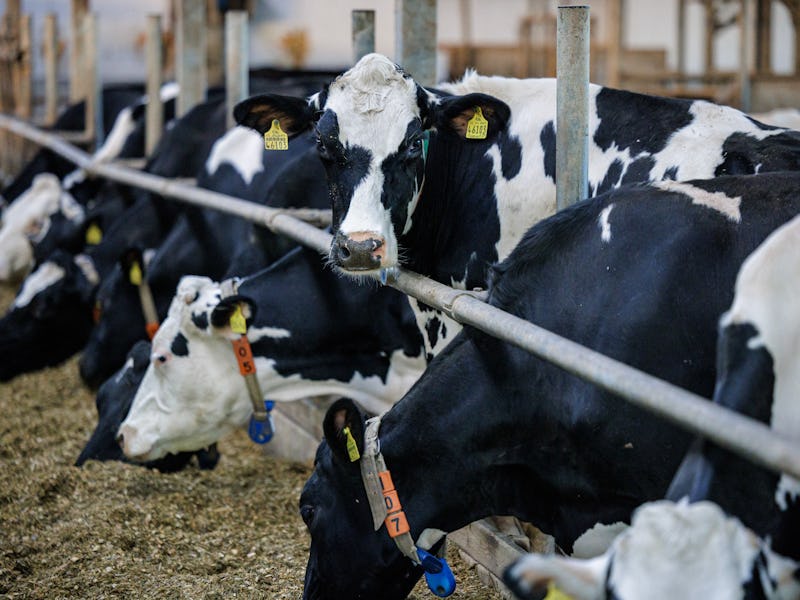Is Milk Safe to Drink Right Now? How Bird Flu in Dairy Cows Affects Milk
Don’t fret and pour yourself a tall glass of milk.

On Monday, state and federal officials announced that what was previously deemed a “mystery cow disease” is actually a highly pathogenic avian influenza (or HPAI), also known as bird flu. Milk and nasal swabs from infected cattle from at least two dairy farms in Kansas and two in Texas tested positive for the H5N1 strain of the influenza virus, a deadly and aggressive form that’s been infecting and killing multiple species in recent years, including humans in very rare cases.
The report follows the first-ever case of bird flu reported in a young goat in western Minnesota and the pernicious outbreak of the virus among poultry. While birds can easily contract the virus, mammals aren’t known to, although it’s happening more often in recent years. This is the first-ever case of bird flu among cows and it’s believed the animals contracted it from infected birds making their migratory pass, as sightings of dead wild birds have been found near farm properties, the Department of Agriculture said.
Does this mean it isn’t safe to drink milk right now? If you’re worried about how this outbreak of bird flu will affect your dairy consumption, rest assured you can pour yourself a cold glass of milk without any worry.
Is it safe to drink dairy milk?
The short answer is yes, as long as it's pasteurized.
“There is no threat to the public and there will be no supply shortages,” Texas Agriculture Commissioner Sid Miller said in a press release. “No contaminated milk is known to have entered the food chain; it has all been dumped. In the rare event that some affected milk enters the food chain, the pasteurization process will kill the virus.”
The U.S. Department of Agriculture also emphasized that there is no current concern or risk to public health.
“Dairies are required to send only milk from healthy animals into processing for human consumption; milk from impacted animals is being diverted or destroyed so that it does not enter the food supply. In addition, pasteurization has continually proven to inactivate bacteria and viruses, like influenza, in milk. Pasteurization is required for any milk entering interstate commerce,” the agency said in its Monday statement.
Drinking unpasteurized (or raw) milk carries many significant dangers, mostly commonly associated with harmful bacteria such as Salmonella, Escherichia coli, and many others that cause foodborne illnesses.
The legal sale of raw milk is still permitted in some states, including Texas and Kansas, but there are stipulations on how the milk is sold. For instance, in Texas, dairy farms selling raw milk have to have it tested every three months; in Kansas, the sale has to take place at the farm and the product has to be explicitly labeled or advertised as raw milk.
The bright side is that unlike poultry, which are culled if they’re infected, cows, for the most part, are recovering just fine (it takes the animals about a week to 10 days). State and federal officials are continuing to monitor the situation among dairy farms nationwide for “additional cases and minimize the impact to farmers, consumers, and other animals,” said the Department of Agriculture.
What is bird flu?
Avian influenza is part of a family of influenza viruses, which come in four types (A, B, C, and D), causing respiratory infections in both animals and humans. Types A (to which avian influenza belongs) and B viruses are responsible for seasonal flu epidemics we commonly associate with the flu season. These two viral types have surface proteins — hemagglutinin and neuraminidase — that constantly switch up, resulting in new strains emerging and causing periodic epidemics (and the reason why we reformulate our flu vaccines every year).
The low pathogenic form of avian influenza (or LPAI) causes either mild or no disease. The highly pathogenic form, as the name suggests, is more concerning since it carries a high mortality rate for infected birds — HPAI causes death in 90 to 100 percent of chickens within 48 hours — and the ability to spread far and outside its usual species target, meaning it could become an emerging threat including to humans who don’t normally get infected.
Bird flu has historically affected poultry but not livestock; cows aren’t considered susceptible to the virus. However, it’s unclear whether the sick cattle in Kansas and Texas each contracted the virus directly from an infected bird or if one sick animal passed it around to the others. Right now, at least, cows and other livestock like goats aren’t considered a host for the virus.
“This finding [of an infected goat] is significant because, while the spring migration is definitely a higher risk transmission period for poultry, it highlights the possibility of the virus infecting other animals on farms with multiple species,” Minnesota State Veterinarian Brian Hoefs said in a press release regarding the case involving the infected goat. “Thankfully, research to date has shown mammals appear to be dead-end hosts, which means they’re unlikely to spread HPAI further.”